Thoughts on the 27th Presidency
by Taylor Reveley
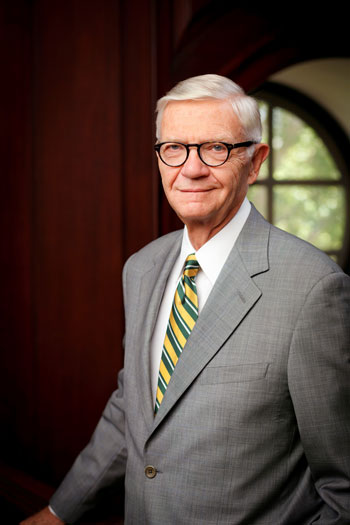 Each William & Mary president stands on the shoulders of prior presidents. Some William & Mary administrations have been times of tremendous accomplishment. After the devastation of the Civil War, simple survival was heroic. I have been keenly aware of the debt I owe those who came before me, particularly those who shaped William & Mary's early success and those in more recent times who laid the foundation to restore the university's preeminence.
Each William & Mary president stands on the shoulders of prior presidents. Some William & Mary administrations have been times of tremendous accomplishment. After the devastation of the Civil War, simple survival was heroic. I have been keenly aware of the debt I owe those who came before me, particularly those who shaped William & Mary's early success and those in more recent times who laid the foundation to restore the university's preeminence.
Often each presidency is more influenced by W&M's past than it imagines. The university's disasters as well as its triumphs over many centuries live on in telling respects. For good and ill William & Mary is a child of its rich history. Fascinated by this history, I have tried to use it to help explain why we are where we are, for instance, why W&M is so poorly endowed despite its colonial preeminence. I have also sought to use history to nurture pride in the magnificence of William & Mary, against a background of what has seemed undue modesty and, indeed, too little awareness of how iconic an American institution W&M truly is.
Presidents depend enormously on the work of countless colleagues to help push the university forward. A successful institution of higher education is a team effort. My presidency has been blessed by colleagues of extraordinary ability and commitment to William & Mary. They have included the two Chancellors of William & Mary with whom I've served, Rectors and members of the Board of Visitors, our administrators, faculty, staff and students, alumni, and W&M's parents and friends. I would have been bereft without their good counsel, friendship, and personal efforts for the good of the whole.
Still, a strong president can be an indispensable catalyst for change. This is especially so if the president knows that great institutions must always be under construction. During the colonial era, William & Mary was the leading institution of higher education in America. My prime ambition has been to quicken the university's progress back to its rightful place in the sun, believing this will serve William & Mary's people well and enhance the good they can do for the Commonwealth, nation, and world.
More specifically, my presidency has had four overriding goals:
First, to pursue excellence in all that William & Mary does, not just in its teaching and research;
Second, to set audacious goals to stretch and galvanize us, even if some seem beyond reach;
Third, to make our strategic planning a "living" process, reflected in the annual cycle of budgets; and
Fourth, to hammer home the reality that going forward William & Mary's financial future, and thus its capacity to excel, hinges largely on our own efforts – faculty, staff and administrators on campus, students and parents, and alumni and friends, with each part of the W&M family pulling strongly on its oar, and no part standing on the sidelines failing to do its part.
The immediate challenges
I became interim president of William & Mary suddenly on February 12, 2008, at 9:30 AM, after receiving a call from Rector Michael Powell. Michael told me to move the university forward, not simply hold the fort as a transitional figure.
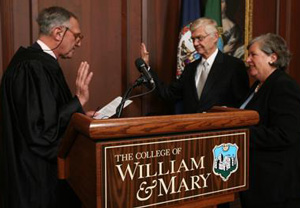 A few days before, the Board of Visitors had decided not to renew President Gene Nichol's contract when it ended on June 30, 2008. Nick resigned effective immediately a few days after receiving this word. My initial challenge was to bring a divided W&M family back together. The immediate need was to restore a campus environment in which faculty, students and staff were undistracted by controversy. Simultaneously we needed to regain the confidence and support of the alumni body, while removing the university from the jaws of the media and state politics. The William & Mary family responded quickly, focused on doing what was necessary to restore momentum and end the disarray so irresistible for the media and so damaging politically.
A few days before, the Board of Visitors had decided not to renew President Gene Nichol's contract when it ended on June 30, 2008. Nick resigned effective immediately a few days after receiving this word. My initial challenge was to bring a divided W&M family back together. The immediate need was to restore a campus environment in which faculty, students and staff were undistracted by controversy. Simultaneously we needed to regain the confidence and support of the alumni body, while removing the university from the jaws of the media and state politics. The William & Mary family responded quickly, focused on doing what was necessary to restore momentum and end the disarray so irresistible for the media and so damaging politically.
A second immediate challenge was the necessity to fill holes in the administrative leadership of the university. Two new vice presidents (out of five) had to be quickly recruited to replace predecessors who were departing in June 2008 and had been great forces at William & Mary for many years. By June 2009 we also had to fill the vital post of provost, following another retirement, and hire a new law school dean to succeed me.
Over the years of my presidency, we have recruited a provost, four new deans (out of six), all vice presidents except one, our first full-time university counsel, our first CFO by that title and an athletic director who followed an AD of long and wonderful tenure, as well as chief officers for compliance, communications, diversity, human resources and internal audit. William & Mary's most senior leadership was largely reconstituted. We also recruited a new Chancellor.
Significant administrative reorganization also occurred. While I was interim, the Office of Strategic Initiatives was created from the former Office of Public Affairs. Next came the creation de novo of the three Offices of University Counsel, Compliance, and Diversity. There followed two major mergers: the Office of Development united with Alumni Affairs to create the Office of Advancement (a step long thought to be politically impossible), and the Offices of Finance and Administration merged, in the process replacing two former vice presidents with one senior VP and W&M's first Chief Financial Officer. We now look continually at ways to restructure for purposes of heightened efficiency and effectiveness.
Finally, there was the need early on, starting during my time as interim, to get William & Mary moving in several key areas. During spring 2008, I urged action to (1) develop a new strategic plan for the university; (2) create more coordinated, telling means of communicating W&M's story – "getting our light out from the under the bushel;" (3) update and reinvigorate the obligatory, or "general education," part of our undergraduate curriculum; and (4) build a new financial foundation for William & Mary much more dependent on our own efforts than on state support.
Strategic planning & BHAGS
The resulting strategic plan was the product of enormous thought and broad participation. It is subject to ongoing revision and it speaks to the annual budget cycle. Among its major emphases have been interdisciplinary curricular initiatives, growing international engagement across the university, heightened emphasis on a diverse and welcoming campus community, changes in the student experience to increase enduring bonds with W&M, improvements in the financial operating model, overhaul of the campus infrastructure and a reorganization and redirection of university communications. As strategic plans go, ours has been a model of effectiveness and long life.
A parallel effort I began in 2013 with the Board of Visitors involves developing BHAGs (Big Hairy Audacious Goals). These goals have timelines and quantitative measures. They are quite bold: to note just a few, having W&M provide and be recognized as providing the best undergraduate education of any college or university, having the best undergraduate retention and graduation rates of any public university, achieving an undergraduate alumni giving participation rate of at least forty percent placing W&M among the top five schools in the country for that accomplishment, making serious progress in the national standing of our graduate and professional programs, and being the first public university of our modest size to launch a campaign for one billion dollars.
Telling W&M's story
Our steps forward in communications – in telling W&M's story – have been numerous, multifaceted, and revolutionary for William & Mary. They have effectively conveyed key information, created delight, and 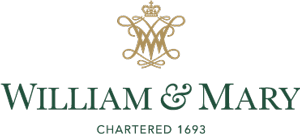 built Tribe Pride. We reorganized to deliver consistent messages across the university through social media, with increasing emphasis on video formats, as well as through traditional written avenues of new excellence. We developed a new visual identity, pushed that through all W&M organizations, and aligned university communications with the themes emerging from the strategic planning process.
built Tribe Pride. We reorganized to deliver consistent messages across the university through social media, with increasing emphasis on video formats, as well as through traditional written avenues of new excellence. We developed a new visual identity, pushed that through all W&M organizations, and aligned university communications with the themes emerging from the strategic planning process.
Part of the new messaging was to make clear that William & Mary is in fact a research university with a distinguished liberal arts college at its core. We emphasized that by referring to the university as "William & Mary" and to the undergraduate program as "the College." We restored emphasis on William & Mary's status as a "Public Ivy," since that description is more apt for us than for any other public university, given our 1693 origin, rich history, tradition of leadership, commitment to the liberal arts, academic distinction and campus beauty. I created and chaired a VP-level Communications Group for the first several years of my presidency to identify opportunities to deliver these key messages and ensure that university communications and events grew in their reach and caliber. We also worked to communicate with flair and fun.
We ran an extremely inclusive process to choose a new mascot for W&M. The Griffin emerged. He/she/it (hard to tell behind the feathers and fur) has been a success. When fully explained, the Griffin says a lot  about the alma mater of the nation. We've adopted a new principal "logo," or bit of iconography, for the university: our historic cypher. We took a Charter Day program, important to understanding W&M's storied past, that was old and tired, moved it to Friday afternoon at 4:00 from Saturday at 10 AM, added a few new elements amid the tried-and-true staples, increased student attendance from 100 or so on Saturday morning to a real crowd on Friday afternoon, and enhanced the pleasure of those who attend. The Homecoming Parade, near death for lack of participation and audience, moved from 8:30 Saturday morning to 4:00 PM on Friday, with a push for more floats and other marching elements. It has new life, with renewed emphasis on reunions. These traditions, along with a host of others, are enhancing Tribe Pride and telling William & Mary's story to students from their freshman year on.
about the alma mater of the nation. We've adopted a new principal "logo," or bit of iconography, for the university: our historic cypher. We took a Charter Day program, important to understanding W&M's storied past, that was old and tired, moved it to Friday afternoon at 4:00 from Saturday at 10 AM, added a few new elements amid the tried-and-true staples, increased student attendance from 100 or so on Saturday morning to a real crowd on Friday afternoon, and enhanced the pleasure of those who attend. The Homecoming Parade, near death for lack of participation and audience, moved from 8:30 Saturday morning to 4:00 PM on Friday, with a push for more floats and other marching elements. It has new life, with renewed emphasis on reunions. These traditions, along with a host of others, are enhancing Tribe Pride and telling William & Mary's story to students from their freshman year on.
In remarks in this country and abroad, I've drawn heavily on William & Mary's deep roots in American history and its education of American leaders to spread the word about the Alma Mater of the Nation. We have reclaimed our alumnus James Monroe with a statue on campus, revitalization of his home "Highland" in Albemarle County, and efforts to gather his papers and seriously study his accomplishments. We have staked a claim to George Washington, who received his surveyor's license from the College and was its first American Chancellor, and have put his portrait in the Great Hall of the Wren along with those of other U.S. Presidents from William & Mary. We have stressed the striking run of contemporary American leaders from W&M, starting with our Chancellor, Bob Gates, Class of 1965. We have used W&M's disastrous 19th century to make sense of some current limitations, such as why our endowment is so small when Harvard's, Yale's and Princeton's are so large. Most important we have spoken far and wide about iconic William & Mary to engender pride among its faithful and encourage robust display of that pride.
Curricular advances
Though renewing the obligatory parts of our undergraduate curriculum took the time and involved the angst typical of major curricular advances, the resulting "general education" curriculum has put W&M back at the cutting edge of liberal arts education for undergraduates. It embraces roughly one-quarter of 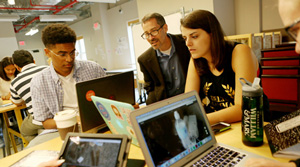 their required graduation credits, runs all four years of their time on campus, cannot be satisfied by AP or like credits from high school, focuses on rigorous thought, effective writing and speaking, and research, entails exposure to each family of the liberal arts, emphasizes international engagement, and ends senior year with a major project designed to pull together the main academic threads of each student's four years at William & Mary. In the old program, students were exposed to the arts and sciences simply by taking unrelated courses in different disciplinary areas, and most of those requirements were completed in the first two years. As just noted, the new program, initiated with the Class of 2019 with a launch in fall 2015, requires a progression of new interdisciplinary courses to be taken throughout the four-year experience. The courses emphasize how to frame questions, reason, create alternatives, solve problems and communicate.
their required graduation credits, runs all four years of their time on campus, cannot be satisfied by AP or like credits from high school, focuses on rigorous thought, effective writing and speaking, and research, entails exposure to each family of the liberal arts, emphasizes international engagement, and ends senior year with a major project designed to pull together the main academic threads of each student's four years at William & Mary. In the old program, students were exposed to the arts and sciences simply by taking unrelated courses in different disciplinary areas, and most of those requirements were completed in the first two years. As just noted, the new program, initiated with the Class of 2019 with a launch in fall 2015, requires a progression of new interdisciplinary courses to be taken throughout the four-year experience. The courses emphasize how to frame questions, reason, create alternatives, solve problems and communicate.
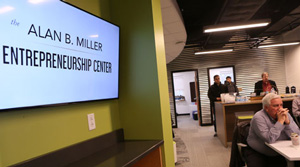 Other curricular advances are underway as well, for instance, in things international, engineering, data science, public policy, and leadership. Thanks to a large Mellon grant, the Alan Miller Entrepreneurship Center and other initiatives, we have heightened emphasis on interdisciplinary work. There is growing commitment to learning online, with the first major initiative having been the Business School's online MBA.
Other curricular advances are underway as well, for instance, in things international, engineering, data science, public policy, and leadership. Thanks to a large Mellon grant, the Alan Miller Entrepreneurship Center and other initiatives, we have heightened emphasis on interdisciplinary work. There is growing commitment to learning online, with the first major initiative having been the Business School's online MBA.
A new financial foundation
At the threshold, a new financial foundation for W&M hinged on persuading the faithful that the era of confident reliance on state operating support was over and never likely to return, though some years will be better than others. The overall trajectory, however, will be declining percentages of state support for our operating budgets, along with declining dollars for each in-state student. It was essential even while interim president for me to begin sounding this message. As one rector observed with tired ears, I've stayed on message relentlessly. There remain few on campus or in the alumni body who cling to belief that W&M's budgets can rely heavily on taxpayer dollars in the years to come.
A new financial foundation for the university hinged as well on effective delivery of a second message – that all members of the W&M family must do their part, with no one standing on the sidelines expecting everyone else to carry the load. (1) Those of us on campus have to become more productive, that's all of us, faculty as well as staff. We have to cut some costs, slow the rate of increase of others, find ways to move funds from less important missions to more important, and develop new means of earning revenue, often via online instruction. This was not a question of working harder. William & Mary people work very hard with few exceptions. It was a question of working smarter, of having systems that make the most sense, and developing new ways to make a buck. (2) Students and families have to pay more tuition, in particular, in-state students have to shoulder more of what it costs to educate them, but always with need-based financial aid for those who lack the means, in whole or part, to pay the costs of the exceptional education W&M provides. (3) Alumni and friends have to answer the call with greatly enhanced philanthropic support, as well assistance to W&M in many other ways. In short, everyone has to do his or her share. We have made great progress on all fronts, accepting the need to take significant risks in order to move forward.
In 2011 I called for a campus-wide effort to identify new efficiencies and revenue opportunities. The push for campus productivity was kicked off by a memorandum followed by a campus-wide meeting. Initial reaction was frigid. But we pushed on and expanded the effort with the provost's reallocation initiative that redirected funds toward our highest priorities. In the ensuing two years we launched over 50 projects to achieve continuing, baseline savings and new revenues. Those productivity efforts at the unit level laid the foundation for a more comprehensive analysis, beginning with a consultant assessment in 2014, about how the university's operating systems could be improved. Subsequent projects, including major changes on the IT and procurement fronts, are on track to reduce baseline expenditures by at least $5 million per year by 2018. We also made a strong push for a larger and more warmly welcomed body of NTE (full-time, non-tenure-eligible) teaching faculty. We included commitment to campus productivity gains as an element in the William & Mary Promise (more about the Promise in a moment), and instituted ongoing oversight of the productivity efforts by the Office of Strategic Initiatives. The concept of productivity is now generally accepted on campus, and it is bearing demonstrable fruit.
We made a Promise in 2013 to sustain William & Mary as a distinguished Public Ivy while making sure that in-state students with demonstrated need could afford to come. This meant significantly increasing in-state tuition to meet pressing needs, but doing so in innovative ways. Though assured for years that any effort to reset in-state tuition at a materially higher level would be politically fatal, we did so with the W&M Promise in the spring of 2013, including a guarantee of a fixed four-year tuition and greatly enhanced need-based aid for in-state students. This constituted a serious upward adjustment of W&M's base of in-state tuition and in-state need-based financial aid. To develop and successfully launch the Promise entailed an enormous amount of collaboration and cooperation between the administration and Board of Visitors, much planning and creative design, extensive preparing of the way with our elected representatives in Richmond, work with the media, and the courage to take a risk for the greater good of W&M. The resulting revenue stream has enabled the university to take crucial steps, especially in faculty and staff compensation. Our compensation had fallen to dangerously low levels compared to our peers, putting W&M's continued capacity to field an outstanding faculty in danger.
We have taken four other risks in our vital quest for greater alumni engagement and philanthropic support. First, though it was thought too politically hazardous within the W&M family to attempt, we 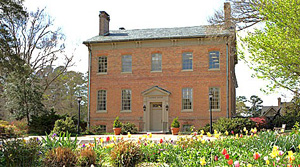 brought the Office of Development together with Alumni Affairs staff under a single vice president (who had previously led the Office of Development), while retaining an independent Alumni Association Board. With some birth pains, this union has resulted in greater efficiency and effectiveness for both alumni engagement and fund raising. Second, we greatly increased the budget for development and alumni engagement, diverting funds from other worthy initiatives to do so. This will make sense long term only if the university's ties to alumni around the world are materially enhanced, leading to support in all sorts of ways, and if we are able to raise materially more funds than ever before and to do so quickly. The early signs are very promising.
brought the Office of Development together with Alumni Affairs staff under a single vice president (who had previously led the Office of Development), while retaining an independent Alumni Association Board. With some birth pains, this union has resulted in greater efficiency and effectiveness for both alumni engagement and fund raising. Second, we greatly increased the budget for development and alumni engagement, diverting funds from other worthy initiatives to do so. This will make sense long term only if the university's ties to alumni around the world are materially enhanced, leading to support in all sorts of ways, and if we are able to raise materially more funds than ever before and to do so quickly. The early signs are very promising.
Third, we have put great emphasis on annual giving, setting a hugely aggressive goal of reaching an annual giving rate of 40% for undergraduate alumni by 2020 and stressing annual giving at every turn. Our audacious goal is to be in the annual-giving company of Princeton, Dartmouth and Notre Dame. I have been the leading apostle of annual giving at William & Mary for many years and now, to my relief and delight, see its wisdom widely embraced.
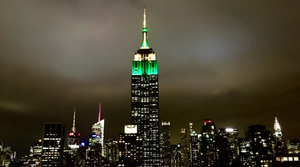 Fourth, after initially believing (and being told by consultants) we could raise at most $600 million in our next campaign, we took the risk of going for a billion dollars. No such sum has ever been raised by a public university as small as W&M.
Fourth, after initially believing (and being told by consultants) we could raise at most $600 million in our next campaign, we took the risk of going for a billion dollars. No such sum has ever been raised by a public university as small as W&M.
By July 1, 2017, more than $712 million has been raised toward the $1 billion goal. Beginning in Fiscal Year 2016, for the first time in W&M's modern history, philanthropy contributed more to our operating budget than state support, except at VIMS.
W&M's aggregate endowment from all sources was $586 million in June 2008 and an estimated $869 million in June 2017, with more than $235+ million also committed (largely in estates) but not yet received. This is progress, though far less than needed.
In a related vein, we have urged the W&M Foundation Board to become a more engaged and effective body, and it has responded wonderfully. By the same token, the Board of Visitors has become dramatically more involved philanthropically, in terms of its own giving, its support for alumni engagement and giving, and the $1 billion campaign. At my urging, we now have an annual joint meeting of the BOV, the W&M Foundation Board, the Alumni Association Board and the Annual Giving Board, so that members of our senior volunteer boards have a chance to know one another and senior administrators, to hear together, at least once a year, plans for the future, and to be heard themselves.
In short, there has been significant progress in building a new financial foundation for the university. We are moving forward on the crucial parallel paths: campus productivity, realistic levels of in-state and out-of-state tuition, coupled with need-based financial aid, and a powerful mix of alumni engagement and philanthropic support. While the way forward will be long and complex, we now have a clear sense of where we're headed and how to get there.
The building boom
The campus has also enjoyed a major physical transformation in recent years, one of the greatest if not the greatest in its long life. From 2008 to 2018 over 1.5 million square feet will have been built or  renewed. That's 40% of the physical resources on the main campus, and more than 50% on the VIMS campus. This has dramatically increased our capacity to do science, brought new life to our professional schools (business, education and law), made serious progress on the facilities that support the humanities and social sciences, improved and expanded our residence halls, and done wonders for some athletic programs. State funding for a major arts complex, desperately needed, has been obtained. Indeed, state funding has been vital for most, though not all, of the capital projects that have contributed so enormously to the physical renewal of William & Mary.
renewed. That's 40% of the physical resources on the main campus, and more than 50% on the VIMS campus. This has dramatically increased our capacity to do science, brought new life to our professional schools (business, education and law), made serious progress on the facilities that support the humanities and social sciences, improved and expanded our residence halls, and done wonders for some athletic programs. State funding for a major arts complex, desperately needed, has been obtained. Indeed, state funding has been vital for most, though not all, of the capital projects that have contributed so enormously to the physical renewal of William & Mary.
A master plan for the development of the main campus for the next 20 years has been completed. It provides a meaningful guide for continued physical progress, both with facilities and with the grounds.
Town & Gown
Close ties and frequent communication with the City of Williamsburg and with our neighbor Colonial Williamsburg have been a priority. Relations with both in recent years have been very strong, despite the inevitable moments of friction in town/gown and neighborly relations.
It has seemed quite important in my judgment that William & Mary expand its footprint in Williamsburg to the extent feasible. Over the course of several years, we vigorously sought to purchase the old Hospitality House, finally succeeding in 2013, thus adding 3.7 acres of prime real estate directly across Richmond Road from the Alumni House. In 2017 we purchased the former Days Inn, adding another 1.6 acres a few blocks west of the campus on Richmond Road. In both instances, a significant number of new dormitory rooms came our way, permitting us to take an old residence hall offline each year for complete renovation. In both instances, we brought new land to the campus that will prove of great value to university in centuries to come.
There has been new emphasis on the campus grounds, already inherently beautiful but in places woefully neglected. Much remains to be done on this score, when funds permit.
Campus climate
Student concerns and needs are myriad, more numerous than in most eras. And, in a way not experienced in the past, social media give events happening in distant places an immediacy to campuses across the country. We have worked hard to anticipate these concerns and needs, and we have tried to move with sufficient speed and sensitivity to maintain civility and calm on campus. Task forces and special committees that I've created have been particularly helpful in engaging difficult matters and proposing ways forward. The provost and I have participated in discussions with faculty, staff and students, encouraging dialogue and the open exchange of ideas. Early during my time as president, the dominant concerns were sustainability and LGBTQ matters. Then focus shifted to drinking and hazing in a few fraternities, along with a "living wage" campaign. Career counseling and placement anxieties, veterans issues, disability issues, mental illness and emotional anxiety, sexual assault and harassment, racial and other diversity challenges, all have their times of primacy, though none ceases to exist on campus.
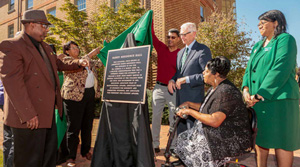 Perhaps especially important because of W&M's awful past with African-Americans, we moved early to create a chief diversity officer and to launch the Lemon Project to study and acknowledge the College's history of slavery, secession and segregation. At our own initiative, we removed Confederate iconography from the university mace and Civil War memorial plaque. We created a task force on racial issues, set up a special fund to spur faculty diversity (the largest new programmatic investment in FY 2017), and named two residence halls for African-Americans important in W&M's past. In 2017-18 we will celebrate the 50th anniversary of the arrival on campus of the first African-American undergraduates to live in a W&M residence hall.
Perhaps especially important because of W&M's awful past with African-Americans, we moved early to create a chief diversity officer and to launch the Lemon Project to study and acknowledge the College's history of slavery, secession and segregation. At our own initiative, we removed Confederate iconography from the university mace and Civil War memorial plaque. We created a task force on racial issues, set up a special fund to spur faculty diversity (the largest new programmatic investment in FY 2017), and named two residence halls for African-Americans important in W&M's past. In 2017-18 we will celebrate the 50th anniversary of the arrival on campus of the first African-American undergraduates to live in a W&M residence hall.
Unfinished business
There is much unfinished business – for instance, in no particular order and no attempt at completeness: our move into engineering design and into leadership studies; work to develop a stronger foothold in health care (scientific advances, ethical considerations, regulatory aspects, economics, politics); the need for W&M to become known as a university, which it has been since 1779, while also continuing to be the "College" so beloved by most older undergraduate alumni; broader recognition of W&M as an institution that does serious research; the push to make our retention and graduate rates the best of any public university; more need-based financial aid for out-of-state students; the future of Richard Bland College; remedying the sad state of Sorority Court; our underfunded grounds and the need to do more for facilities maintenance and renewal; bringing our $1 billion campaign to a successful conclusion; expanding our forays into on-line education, particularly in our professional and graduate schools; and delivering the Arts Complex.
Committed leadership
If ties fray between the Board of Visitors, on the one hand, and the president and campus community, on the other, the university's progress slows to a crawl and begins to recede. Maintaining strong ties and ensuring common understandings takes constant work. Unity of purpose starts with a close working relationship among the president, rector and Board of Visitors as a whole. We have been blessed in my time with extraordinary members and leaders on our Board, people of vision and courage. This was nowhere more evident than in the Board's leadership in pushing for bold goals and advancing, though the Promise, the means to help achieve them.
All of us together, chancellors, boards, president, campus community and alumni seek excellence in all that William & Mary does. We have made enormous progress in recent years. The William & Mary family is strong and united in our commitment to the growing good done by the Alma Mater of the Nation, just as we are to its national prominence and international stature.
We're on course for the 21st century to be the most compelling in William & Mary's long life.
W&M's powerful hold
Let me end on a more personal note. I didn't go to college or law school at William & Mary. Indeed, I was long in the tooth before I knew the College by anything but its stereotypic reputation – really old, really hard academically. So how did William & Mary come to capture my heart and mind so completely? How did I come to have such respect and affection, even love, for a school I never attended and didn't seriously encounter until my mid-fifties?
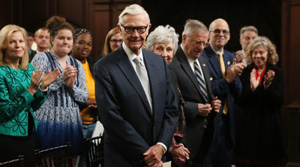 Was I seduced by the physical allure of William & Mary's campus? It is, by any measure, one of the most beautiful in the country, in the world for that matter. I love to walk its varied precincts, and to find its western grounds flowing into 700 acres of pristine College Woods and its eastern grounds merging gracefully into the late 18th century reborn in Colonial Williamsburg.
Was I seduced by the physical allure of William & Mary's campus? It is, by any measure, one of the most beautiful in the country, in the world for that matter. I love to walk its varied precincts, and to find its western grounds flowing into 700 acres of pristine College Woods and its eastern grounds merging gracefully into the late 18th century reborn in Colonial Williamsburg.
Was I mesmerized by the rich history that William & Mary has lived over the centuries? You can't manufacture history out of nothing; you have to live it, and the College has lived it to astonishing degree since 1693, leading the way for higher education in key respects, educating leaders for communities, states and nation, and making its way indomitably through times of terrible loss and turmoil. There have been times, too, in which we can take no pride, times of slavery, secession and segregation. But we have moved beyond them, acknowledged their ills, and seek to learn from them. William & Mary's past, both its triumphs and tragedies, is one from which we can draw abiding strength for all time coming.
Was it the high caliber of William & Mary's people that drew me close? William & Mary people are remarkably intelligent, hard-working, and ambitious. They are also collegial, caring and free of the cloying sense of entitlement that sometimes blights very accomplished humans. They are the sort of people with whom you enjoy being and on whom you can count for splendid performance.
Was I won by William & Mary's pervasive academic excellence and its commitment to being a research university while remaining a great teaching institution for undergraduates as well as graduate and professional students?
Was it William & Mary's unequalled capacity to do more with less in all aspects of its life that was so inspiring for me, even while we moved heaven and earth to reach that happy day when the university can do more with more?
Was it the deep loyalty of William & Mary people to the Alma Mater of the Nation and their pride in what the College has been and the research university it has become?
Well, of course, it was all of this and more that accounts for William & Mary's powerful hold on my respect and affection.
When I became William & Mary's 27th president, I promised to do my best for this magnificent institution. We've come a very long way together. It has been an extremely meaningful time for me. Thank you William & Mary for what you have given me and so many others over the centuries, and thank you for the great good you are going to do for all time coming.















